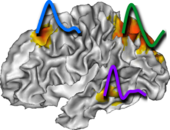pyhrf.ndarray module¶
This module provides classes and functions to handle multi-dimensionnal numpy array (ndarray) objects and extend them with some semantics (axes labels and axes domains). See xndarray class. (TODO: make xndarray inherit numpy.ndarray?)
-
exception
pyhrf.ndarray.ArrayMappingError¶ Bases:
exceptions.Exception
-
pyhrf.ndarray.expand_array_in_mask(flat_data, mask, flat_axis=0, dest=None, m=None)¶ Map the flat_axis of flat_data onto the region within mask. flat_data is then reshaped so that flat_axis is replaced with mask.shape
m is the result of np.where(mask) -> can be passed to speed up if already done before
Example 1 >>> a = np.array([1,2,3]) >>> m = np.array([[0,1,0], [0,1,1]] ) >>> expand_array_in_mask(a,m) array([[0, 1, 0],
[0, 2, 3]])Example 2 >>> a = np.array([[1,2,3],[4,5,6]]) >>> m = np.array([[0,1,0], [0,1,1]] ) >>> expand_array_in_mask(a,m,flat_axis=1) array([[[0, 1, 0],
[0, 2, 3]],- <BLANKLINE>
- [[0, 4, 0],
- [0, 5, 6]]])
-
pyhrf.ndarray.merge(arrays, mask, axis, fill_value=0)¶ Merge the given arrays into a single array according to the given mask, with the given axis being mapped to those of mask. Assume that arrays[id] corresponds to mask==id and that all arrays are in the same orientation.
- Arg:
arrays (dict of xndarrays):
- mask (xndarray): defines the mapping between the flat axis in the
arrays to merge and the target expanded axes.
axis (str): flat axis for the
-
pyhrf.ndarray.split_and_save(cub, axes, fn, meta_data=None, set_MRI_orientation=False, output_dir=None, format_dvalues=False)¶
-
pyhrf.ndarray.stack_cuboids(c_list, axis, domain=None, axis_pos='first')¶ Stack xndarray instances in list ‘c_list’ along a new axis label ‘axis’. If ‘domain’ (numpy array or list) is provided, it is associated to the new axis. All cuboids in ‘c_list’ must have the same orientation and domains. ‘axis_pos’ defines the position of the new axis: either ‘first’ or ‘last’.
Example: >>> import numpy as np >>> from pyhrf.ndarray import xndarray, stack_cuboids >>> c1 = xndarray(np.arange(4*3).reshape(4,3), [‘x’,’y’]) >>> c1 axes: [‘x’, ‘y’], array([[ 0, 1, 2],
[ 3, 4, 5], [ 6, 7, 8], [ 9, 10, 11]])>>> c2 = xndarray(np.arange(4*3).reshape(4,3)*2, ['x','y']) >>> c2 axes: ['x', 'y'], array([[ 0, 2, 4], [ 6, 8, 10], [12, 14, 16], [18, 20, 22]]) >>> c_stacked = stack_cuboids([c1,c2], 'stack_axis', ['c1','c2']) >>> print c_stacked.descrip() * shape : (2, 4, 3) * dtype : int64 * orientation: ['stack_axis', 'x', 'y'] * value label: value * axes domains: 'stack_axis': array(['c1', 'c2'], dtype='|S2') 'x': arange(0,3,1) 'y': arange(0,2,1)
TODO: enable broadcasting (?)
-
pyhrf.ndarray.tree_to_xndarray(tree, level_labels=None)¶ Stack all arrays within input tree into a single array.
Parameters: - tree (-) – nested dictionnaries of xndarray objects. Each level of the tree correspond to a target axis, each key of the tree correspond to an element of the domain associated to that axis.
- level_labels (-) – axis labels corresponding to each level of the tree
Returns: xndarray object
Example: >>> from pyhrf.ndarray import xndarray, tree_to_xndarray >>> d = { 1 : { .1 : xndarray([1,2], axes_names=[‘inner_axis’]), .2 : xndarray([3,4], axes_names=[‘inner_axis’]), }, 2 : { .1 : xndarray([1,2], axes_names=[‘inner_axis’]), .2 : xndarray([3,4], axes_names=[‘inner_axis’]), } } >>> tree_to_xndarray(d, [‘level_1’, ‘level_2’]) axes: [‘level_1’, ‘level_2’, ‘inner_axis’], array([[[1, 2],
[3, 4]],- <BLANKLINE>
- [[1, 2],
- [3, 4]]])
-
class
pyhrf.ndarray.xndarray(narray, axes_names=None, axes_domains=None, value_label='value', meta_data=None)¶ Handles a multidimensional numpy array with axes that are labeled and mapped to domain values.
Example : c = xndarray( [ [4,5,6],[8,10,12] ], [‘time’,’position’], {‘time’:[0.1,0.2]} ) Will represent the following situation:
position ——-> 4 5 6 | t=0.1 |time 8 10 12 | t=0.2 v
-
add(c, dest=None)¶
-
astype(t)¶
-
cexpand(cmask, axis, dest=None)¶ Same as expand but mask is a cuboid
TODO: + unit test
-
cflatten(cmask, new_axis)¶
-
copy(copy_meta_data=False)¶ Return copy of the current cuboid. Domains are copied with a shallow dictionnary copy.
-
descrip()¶ Return a printable string describing the cuboid.
-
descrip_shape()¶
-
divide(c, dest=None)¶
-
expand(mask, axis, target_axes=None, target_domains=None, dest=None, do_checks=True, m=None)¶ Create a new xndarray instance (or store into an existing ‘dest’ cuboid) where ‘axis’ is expanded and values are mapped according to ‘mask’. ‘target_axes’ is a list of the names of the new axes replacing ‘axis’. ‘target_domains’ is a dict of domains for the new axes.
Example: >>> import numpy as np >>> from pyhrf.ndarray import xndarray >>> c_flat = xndarray(np.arange(2*6).reshape(2,6).astype(np.int64), [‘condition’, ‘voxel’], {‘condition’ : [‘audio’,’video’]}) >>> print c_flat.descrip() # doctest: +NORMALIZE_WHITESPACE * shape : (2, 6) * dtype : int64 * orientation: [‘condition’, ‘voxel’] * value label: value * axes domains:
- ‘condition’: array([‘audio’, ‘video’],
- dtype=’|S5’)
‘voxel’: arange(0,5,1)
>>> mask = np.zeros((4,4,4), dtype=int) >>> mask[:3,:2,0] = 1 >>> c_expanded = c_flat.expand(mask, 'voxel', ['x','y','z']) >>> print c_expanded.descrip() * shape : (2, 4, 4, 4) * dtype : int64 * orientation: ['condition', 'x', 'y', 'z'] * value label: value * axes domains: 'condition': array(['audio', 'video'], dtype='|S5') 'x': arange(0,3,1) 'y': arange(0,3,1) 'z': arange(0,3,1)
-
explode(cmask, new_axis='position')¶ Explode array according to the given n-ary mask so that axes matchin those of mask are flatten into new_axis.
Parameters: - mask (-) – n-ary mask that defines “regions” used to split data
- new_axis (-) – target flat axis
Returns: dict of xndarray that maps a mask value to a xndarray.
-
explode_a(mask, axes, new_axis)¶ Explode array according to given n-ary mask so that axes are flatten into new_axis.
Parameters: - mask (-) – n-ary mask that defines “regions” used to split data
- axes (-) – list of axes in the current object that are mapped onto the mask
- new_axis (-) – target flat axis
Returns: dict of xndarray that maps a mask value to a xndarray.
-
fill(c)¶
-
flatten(mask, axes, new_axis)¶ flatten cudoid.
TODO: +unit test
-
get_axes_domains()¶ Return domains associated to axes as a dict (axis_name:domain array)
-
get_axes_ids(axes_names)¶ Return the index of all axes in given axes_names
-
get_axis_id(axis_name)¶ Return the id of an axis from the given name.
-
get_axis_name(axis_id)¶ Return the name of an axis from the given index ‘axis_id’.
-
get_domain(axis_id)¶ Return the domain of the axis axis_id
example: >>> from pyhrf.ndarray import xndarray >>> c = xndarray(np.random.randn(10,2), axes_names=[‘x’,’y’], axes_domains={‘y’ : [‘plop’,’plip’]}) >>> (c.get_domain(‘y’) == np.array([‘plop’, ‘plip’], dtype=’|S4’)).all() True >>> c.get_domain(‘x’) #default domain made of slice indexes array([0, 1, 2, 3, 4, 5, 6, 7, 8, 9])
-
get_domain_idx(axis, value)¶ Get slice index from domain value for axis ‘axis’.
-
get_dshape()¶ Return the shape of the array as dict mapping an axis name to the corresponding size
-
get_extra_info(fmt='dict')¶
-
get_ndims()¶
-
get_new_axis_name()¶ Return an axis label not already in use. Format is: dim%d
-
get_orientation()¶
-
get_voxel_size(axis)¶ Return the size of a voxel along ‘axis’, only if meta data is available.
-
has_axes(axes)¶
-
has_axis(axis)¶
-
len(axis)¶
-
static
load(file_name)¶ Load cuboid from file. Supported format: nifti1. Extra axis information is retrieved from a nifti extension if available. If it’s not available, label the axes as: (sagittal, coronal, axial[, time]).
TODO: gifti.
-
map_onto(xmapping)¶ Reshape the array by mapping the axis corresponding to xmapping.value_label onto the shape of xmapping. :param - xmapping: array whose attribute value_label
matches an axis of the current arrayReturns: - a new array (xndarray) where values from the current array have been mapped according to xmapping
Example: >>> from pyhrf.ndarray import xndarray >>> import numpy as np >>> # data with a region axis: >>> data = xndarray(np.arange(2*4).reshape(2,4).T * .1, [‘time’, ‘region’], {‘time’:np.arange(4)*.5, ‘region’:[2, 6]}) >>> data axes: [‘time’, ‘region’], array([[ 0. , 0.4],
[ 0.1, 0.5], [ 0.2, 0.6], [ 0.3, 0.7]])>>> # 2D spatial mask of regions: >>> region_map = xndarray(np.array([[2,2,2,6], [6,6,6,0], [6,6,0,0]]), ['x','y'], value_label='region') >>> # expand region-specific data into region mask >>> # (duplicate values) >>> data.map_onto(region_map) axes: ['x', 'y', 'time'], array([[[ 0. , 0.1, 0.2, 0.3], [ 0. , 0.1, 0.2, 0.3], [ 0. , 0.1, 0.2, 0.3], [ 0.4, 0.5, 0.6, 0.7]], [[ 0.4, 0.5, 0.6, 0.7], [ 0.4, 0.5, 0.6, 0.7], [ 0.4, 0.5, 0.6, 0.7], [ 0. , 0. , 0. , 0. ]], [[ 0.4, 0.5, 0.6, 0.7], [ 0.4, 0.5, 0.6, 0.7], [ 0. , 0. , 0. , 0. ], [ 0. , 0. , 0. , 0. ]]])
-
max(axis=None)¶
-
mean(axis=None)¶
-
min(axis=None)¶
-
multiply(c, dest=None)¶
-
ptp(axis=None)¶
-
reorient(orientation)¶ Return a cuboid with new orientation. If cuboid is already in the right orientation, then return the current cuboid. Else, create a new one.
-
repeat(n, new_axis, domain=None)¶ Return a new cuboid with self’s data repeated ‘n’ times along a new axis labelled ‘new_axis’. Associated ‘domain’ can be provided.
-
rescale_values(v_min=0.0, v_max=1.0, axis=None)¶
-
roll(axis, pos=-1)¶ Roll xndarray by making ‘axis’ the last axis. ‘pos’ is either 0 or -1 (first or last, respectively) TODO: handle all pos.
-
save(file_name, meta_data=None, set_MRI_orientation=False)¶ Save cuboid to a file. Supported format: Nifti1. ‘meta_data’ shoud be a 2-elements tuple: (affine matrix, Nifti1Header instance). If provided, the meta_data attribute of the cuboid is ignored. All extra axis information is stored as an extension.
-
set_MRI_orientation()¶ Set orientation to sagittal,coronal,axial,[time|iteration|condition] Priority for the 4th axis: time > condition > iteration. The remaining axes are sorted in alphatical order
-
set_axis_domain(axis_id, domain)¶ Set the value domain mapped to axis_id as domain
Parameters: - axis_id (-) – label of the axis
- domain (-) – value domain
Returns: None
-
set_orientation(axes)¶ Set the cuboid orientation (inplace) according to input axes labels
-
split(axis)¶ Split a cuboid along given axis. Return an OrderedDict of cuboids.
-
squeeze(axis=None)¶ Remove all dims which have length=1. ‘axis’ selects a subset of the single-dimensional axes.
-
squeeze_all_but(axes)¶
-
std(axis=None)¶
-
sub_cuboid(orientation=None, **kwargs)¶ Return a sub cuboid. ‘kwargs’ allows argument in the form: axis=slice_value.
-
sub_cuboid_from_slices(orientation=None, **kwargs)¶ Return a sub cuboid. ‘kwargs’ allows argument in the form: axis=slice_index.
-
substract(c, dest=None)¶
-
sum(axis=None)¶
-
swapaxes(a1, a2)¶ Swap axes a1 and a2
Parameters: - a1 (-) – identifier of the 1st axis
- a2 (-) – identifier of the 2nd axis
Returns: A new cuboid wrapping a swapped view of the numpy array
-
to_html_table(row_axes, col_axes, inner_axes, cell_format='txt', plot_dir=None, rel_plot_dir=None, plot_fig_prefix='xarray_', plot_style='image', plot_args=None, tooltip=False, border=None)¶ Render the array as an html table whose column headers correspond to domain values and axis names defined by col_axes, row headers defined by row_axes and inner cell axes defined by inner_axes Data within a cell can be render as text or as a plot figure (image files are produced)
Parameters: - – Returns: html code (str)
-
to_latex(row_axes=None, col_axes=None, inner_axes=None, inner_separator=' | ', header_styles=None, hval_fmt=None, val_fmt='%1.2f', col_align=None)¶
-
to_tree(level_axes, leaf_axes)¶ Convert nested dictionary mapping where each key is a domain value and each leaf is an array or a scalar value if leaf_axes is empty.
Returns: {dv_axis1 : {dv_axis2 : {... : xndarray|scalar_type} Return type: OrderedDict such as Example: >>> from pyhrf.ndarray import xndarray >>> import numpy as np >>> c = xndarray(np.arange(4).reshape(2,2), axes_names=[‘a1’,’ia’], axes_domains={‘a1’:[‘out_dv1’, ‘out_dv2’], ‘ia’:[‘in_dv1’, ‘in_dv2’]}) >>> c.to_tree([‘a1’], [‘ia’]) OrderedDict([(‘out_dv1’, axes: [‘ia’], array([0, 1])), (‘out_dv2’, axes: [‘ia’], array([2, 3]))])
-
unstack(outer_axes, inner_axes)¶ Unstack the array along outer_axes and produce a xndarray of xndarrays
Parameters: - outer_axes (-) – list of axis names defining the target unstacked xndarray
- inner_axes (-) – list of axis names of any given sub-array of the target unstacked xndarray
Returns: xndarray object
Example: >>> from pyhrf.ndarray import xndarray >>> import numpy as np >>> c = xndarray(np.arange(4).reshape(2,2), axes_names=[‘a1’,’ia’], axes_domains={‘a1’:[‘out_dv1’, ‘out_dv2’], ‘ia’:[‘in_dv1’, ‘in_dv2’]}) >>> c.unstack([‘a1’], [‘ia’]) axes: [‘a1’], array([axes: [‘ia’], array([0, 1]), axes: [‘ia’], array([2, 3])], dtype=object)
-
var(axis=None)¶
-
static
xndarray_like(c, data=None)¶ Return a new cuboid from data with axes, domains and value label copied from ‘c’. If ‘data’ is provided then set it as new cuboid’s data, else a zero array like c.data is used.
TODO: test
-
-
pyhrf.ndarray.xndarray_like(c, data=None)¶


